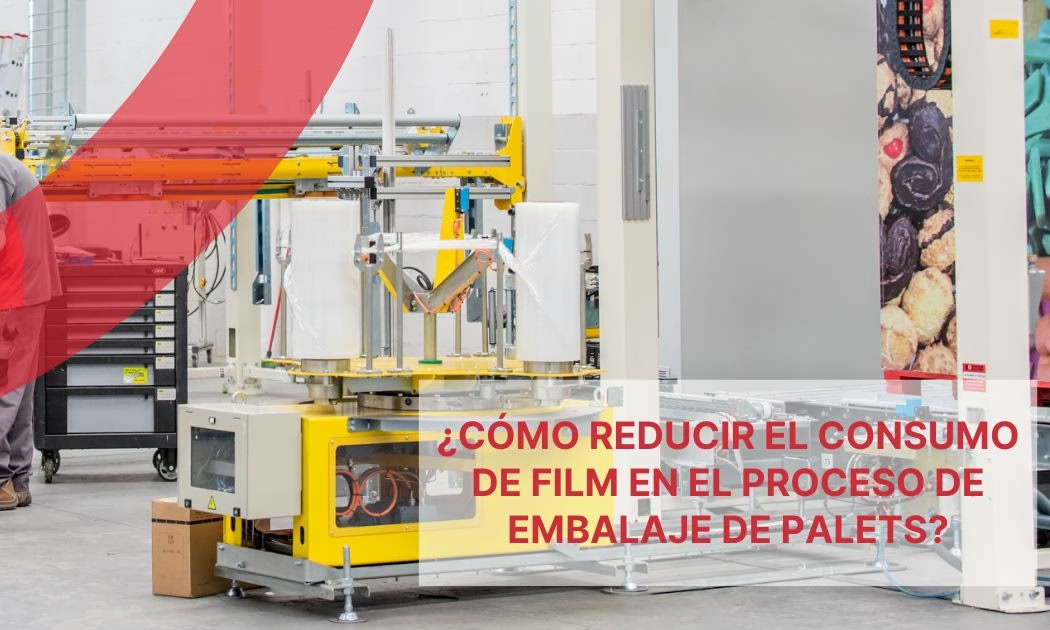Reducing the consumption of film when wrapping pallets is key because it helps optimize costs in the company. Want to know what ways exist without compromising a good result? Keep reading…
Ways to reduce the consumption of film when wrapping pallets
It’s true that there are different types of stretch film for packaging, whether automatic or manual, made from BOPP, BOPA, EVOH, or CPA. But they all have in common the fact that they are made from plastic, a material produced, among other raw materials, from petroleum.
Therefore, the cost of film is associated with that of petroleum, as it is a derivative. An increase in raw materials is quickly passed on, which could create issues with costs. If you want to be competitive, this is something that must be managed intelligently.
However, using film to wrap pallets is a necessity for safety, stability, and space management reasons. The best option to achieve professional and efficient pallet wrapping is using a wrapping machine; regardless of the sector you work in, the differences will be noticeable, and a lot. Therefore, it should not be surprising that this type of technology has become more common in recent years.
Do you want to know what you can do to effectively reduce film consumption without compromising the wrapping result? Here are 5 useful tips for doing so with the help of a wrapping machine:
1. Minimize film scraps and tails
One of the recurring problems is the scraps and tails of film. At first, you may use little, but if you add up all the scraps, you’ll probably notice it in the long run. For this reason, it is highly recommended to make the most of the film when wrapping pallets, especially paying attention to these elements.
What should be noted is that, with manual wrapping, it is more likely that more scraps and tails will be left behind. After all, there isn’t the same precision or mathematical calculation. It’s worth considering this point because there is an opportunity for savings here.
2. Stretch the film more
The more you stretch the film, as long as it is of good quality, the greater the savings in product. Remember, a wrapping machine always provides a better result than manual wrapping.
If you use a wrapping machine and program it, you can achieve a stretching capacity of 300%. Or, in other words, for every meter of film, you’ll get 4 stretches. It’s no secret that this is an intelligent way to save supplies in the long run. Especially if you make intensive use of film for palletizing. Many SMEs spend more than necessary because they do not properly calculate how far the film can be stretched.
Moreover, wrapping also helps achieve a professional result, which the customer will also appreciate. Consequently, it is a recommended technique to avoid any kind of problem.
3. Use good quality film
Although this may seem obvious, it’s worth mentioning: the quality of the film greatly influences the result. The reason? Poor-quality film is more likely to break when stretched, and that’s material you waste.
The saying “sometimes cheap is expensive” holds true when buying stretch film. It might be worth spending a few extra cents and, in exchange, getting certain quality guarantees. Since the materials vary, it’s not a bad idea to consult and ensure that the type of film is compatible with the machinery.
In any case, it’s also true that if the film is of good quality, an automatic machine will help ensure it performs at its best. It can be stretched more without compromising its integrity.
4. Reduce film consumption through recycling (whenever possible)
It’s true that if you use a high-quality wrapping machine, the chances of wasting product are minimal. But still, as a general principle, you should recycle materials if you have that option.
For example, if there is a small scrap left or you have a return and the film is in good condition, you can find an alternative use for it without compromising the quality of the results. This action, as long as it’s done thoughtfully, will allow you to save money, and that adds up in the long run.
Recycling, moreover, is a sustainable attitude that’s part of a Corporate Social Responsibility (CSR) policy, which generates credibility.
5. Wrap the base of the pallet properly
The base of the pallet must be well-wrapped because breakages are common, and a significant amount of film could be wasted in that area. Therefore, you must be particularly careful to avoid using more material than necessary.
Manual wrapping at the base is especially costly and complicated. Once again, the use of specialized machinery becomes the best option. Not only for the finish on the pallet, but also for the wrapping speed. The Saturn S8, for example, can provide a reliable result.
And there’s another point we can’t overlook: the faster this process is done, the better.
6. Wrap in a cross-pattern
Wrapping pallets in a cross-pattern is another methodology that allows significant savings in film, and more importantly, it improves safety. This procedure essentially involves closing one part, and then doing the same perpendicularly. This way, you avoid having to use layer after layer to properly secure the load.
Wrapping, for all these reasons, is a very interesting option because you save a lot of film. While the technique works well manually or with an automatic machine, the result is undoubtedly better with the latter.
Conclusion
Reducing film consumption with these best practices is possible, and all while ensuring good service. Want to be more efficient in pallet wrapping? Don’t worry, at Movitec, we have various options adapted to what you need. Contact us to learn more!
